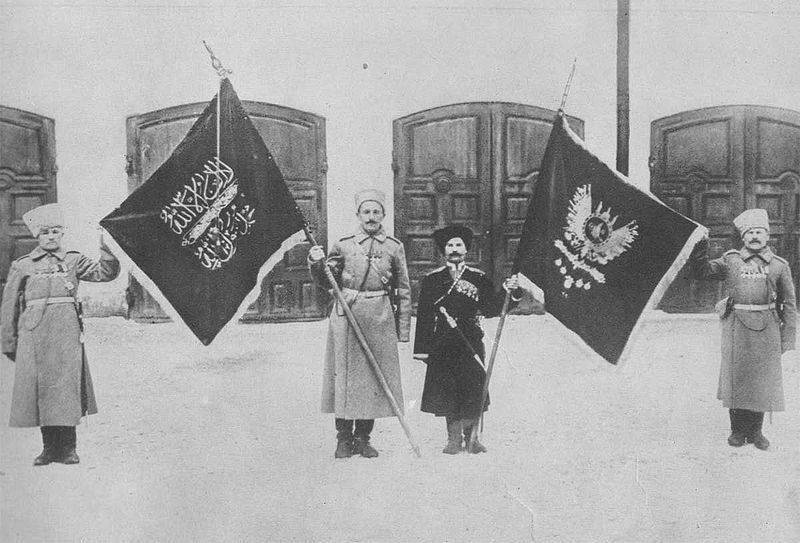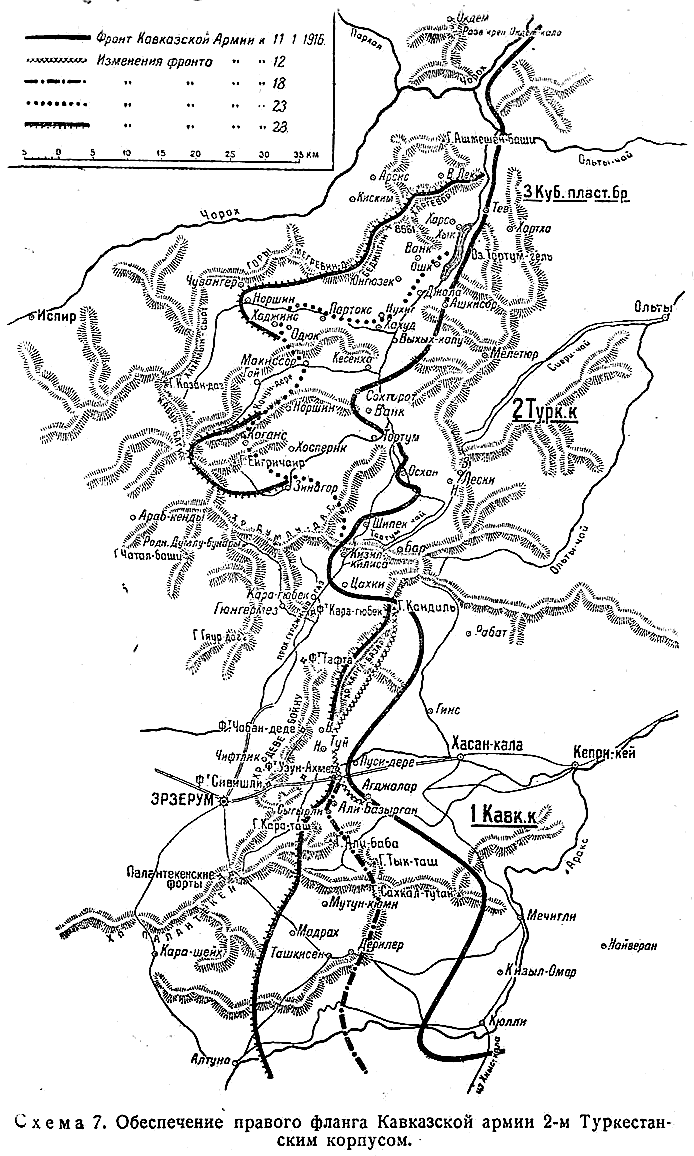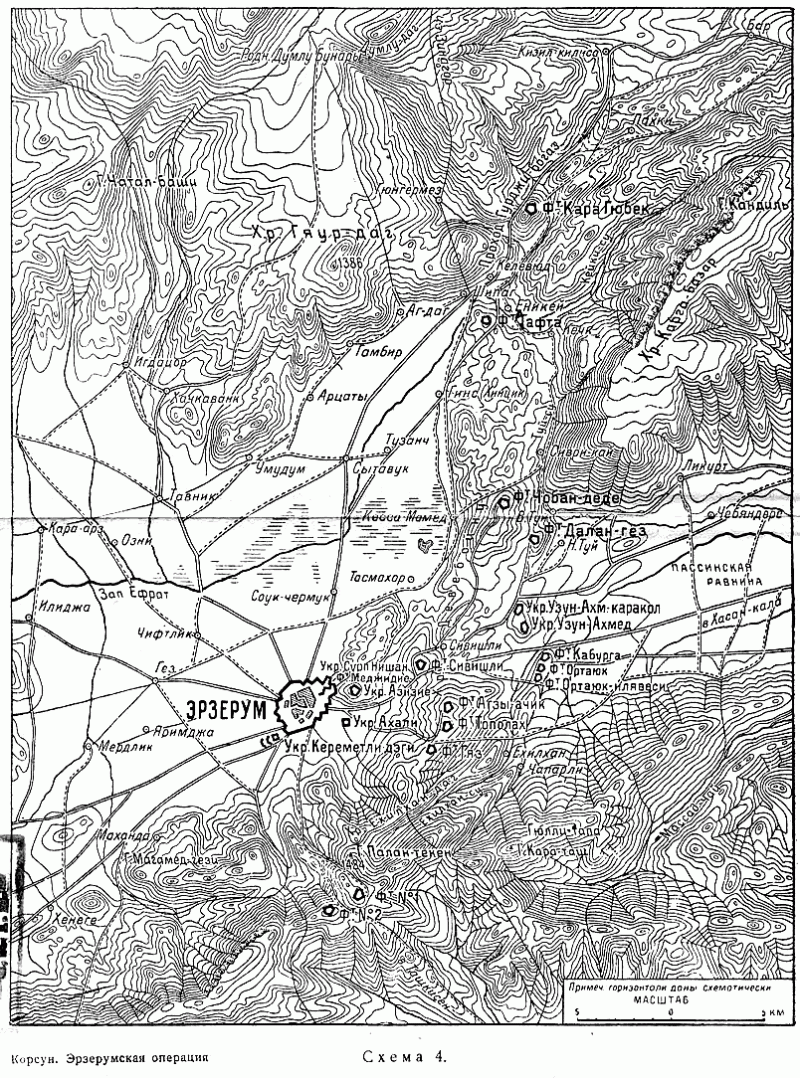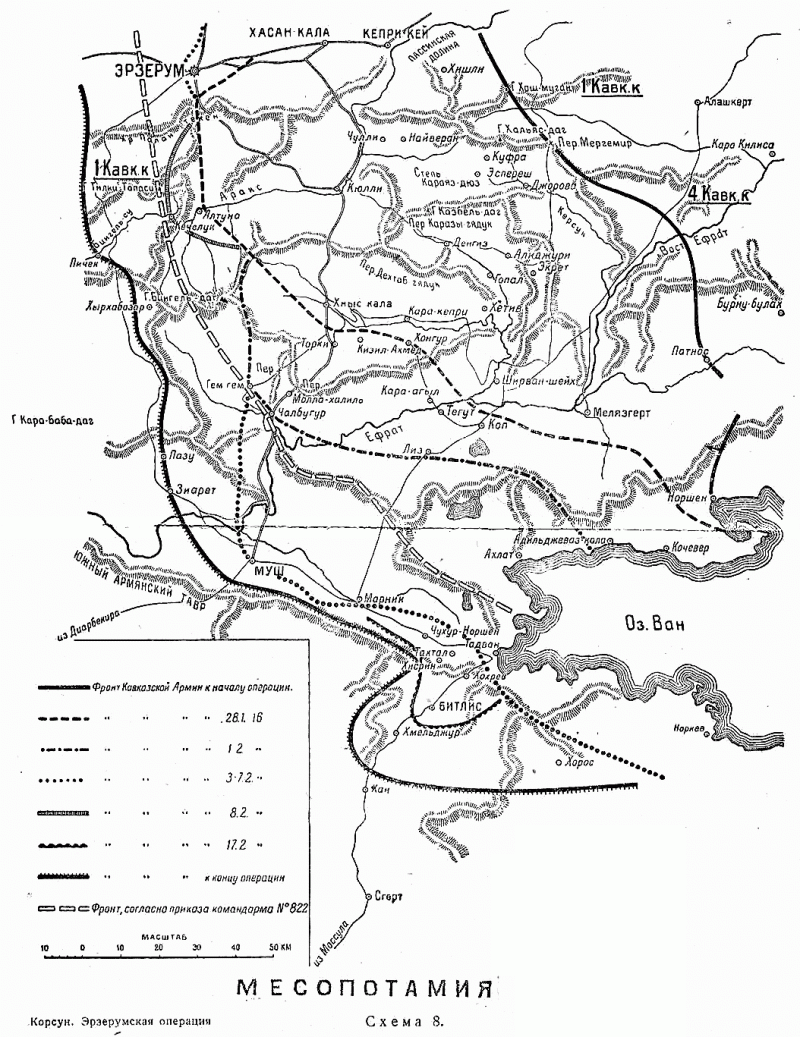Assault Erzerum

“The Lord God rendered so great help to the super-victorious troops of the Caucasian army that Erzerum was taken after a five-day unprecedented assault,” Grand Duke Nikolai Nikolayevich informed the emperor. Erzurum assault surprised Russia and shook the other powers. The Russian army took the fortress that was considered impregnable. Turkey was forced to quit the British aspiring and turn all attention to the Russian army.
Defense system of Erzerum fortress
Erzerum was the most important fortress of the Ottoman Empire on the Caucasian front. First, it was a whole fortified area that binds the entire Turkish front in the Caucasus into a single whole. Secondly, it was the main base of the Turks for offensive and defensive operations in the South Caucasus. Third, Erzerum was the main hub of all communications from the Transcaucasus and Persia to Anatolia. In fact, it was the "key" to Anatolia. The capture of Erzerum opened the way to Anatolia and further to Constantinople.
The fortress was very advantageously located in the Erzurum upland plain, which excluded the possibility for the attacker, who did not have a significant superiority in strength, to bypass and block this fortress. This was a feature of the Erzurum fortress, it could not be blocked by part of the forces and bypass, it was necessary to go to the assault in order to go further. The Erzerum Highland Plain lies in a belt of mountain plateaus, the only one convenient for the operation of troops moving from east to west. This lane east of Erzerum is crossed by the Debeboyna Range, which represents a strong position with the front to the east; the flanks of this position abut the difficult mountain ranges: in the north - the wild spurs of the Karga Bazar ridge, in the south - the Palanteken ridge. Thus, this position represents a convex arc with secured flanks and blocks access to the Erzerum plain from the east.
From the north, the Erzurum Plain highland is provided with inaccessible mountains surrounding the r. Chorokh, from the south - the Bingel-Dag ridge (South Taurus). And only the strip of the upland plain r. The Eastern Euphrates, going south of Bingel-Dag, made it possible to bypass the Erzerum upland plain from the south along circular and distant paths. Thus, this natural natural springboard, secured from the flanks and from the front, reliably covered the whole of Western Armenia and Anatolia from the Transcaucasus, locking directly all roads from the South Caucasus. The capture of Erzerum was of strategic importance, since it gave the Russians all of Armenia and opened access to Anatolia.
The Ottomans understood all this well. Erzerum before was a powerful fortress. Turks after the Russian-Turkish war 1877-1878 strengthened all the ways to the Erzerum plain from the Transcaucasus, turning the fortress into a real fortified area. Before the World War, the Turkish General Staff drafted several projects of new fortifications of Erzerum, but the preparatory work was interrupted by the beginning of the war. A German general, General Posselt, who worked to strengthen the fortifications of this fortress until March 1915 together with two German specialists, was sent to Erzerum as commandant. Under their leadership, they were equipped with field fortifications positions on the line of forts, the number of artillery and machine gun positions was increased. Thus, Erzerum was a huge fortified area, where old and new fortifications were combined with natural factors, which made the fortress almost impregnable.
True, the Turks lost the opportunity to make Erzurum completely impregnable, without taking care of the engineering equipment of the powerful Keprikei positions and the fortress of Hasan-Kala, as well as the transformation of nearby settlements into strong footholds. These positions were relatively easily occupied by the Russian army during the Ceprikei operation, which made it possible to begin the assault on Erzerum itself.
The city itself was surrounded by a continuous fence of the bastion type, with strong points on the hills: in the north-east there were the fortifications of Medgidiye and the two lunettes Aziziye; in the south-west was the fort of Keremetli-degi with advanced lunettes; Akhali Redoubt was advanced to the southeast of the city wall. The fortress fence had a long-term character and was surrounded by a deep moat (up to 6,5 m depth). However, it was already outdated, since it did not have additional protection against artillery, and the ramparts, due to the flows flowing down from the mountains, had scour gaps. Therefore, the fortress alone could not withstand the attacks of the modern army. Her strength was in the fortifications carried out on 10-12 km from the city to the position of Deboin's fortifications, which provided the fortress and its warehouses from bombardment.
The position of Deboin, a length of about 16 km, was located on the ridge that served as the watershed between the basins of the Araks and Western Euphrates rivers and separated the Passinskaya plain from Erzerum. At a distance of 1-2 km to the east of the Deveboin Range and parallel to it on the spurs of this range there were a number of separate heights (from 2000 to 2100 m), dominating directly above the plain. 11 of 1877-1878 built after the war was located on these hills. long-term fortifications located in two lines.
The first line consisted of five forts and two batteries, starting from the north: Fort Choban-dede, Fort Dalan-gez, two batteries (Uzun-Ahmed-Karakol and Uzun-Ahmed), and three forts - Kaburga, Ortayuk and Ortayuk-Ilyasi). In addition, on the right flank of the first fortification line there were only trenches and field batteries. The length of the forts of the first line, counting along their circumference - 17,5 km, and in a straight line - 13 km. In the second line there were four forts, from the north: Sivishli, Agzi-achik, Topolov and Gyaz. The extension of the second line of fortifications from the fort of Gyaz to the fort of Sivishli - 5 km. The third line of defense was the fortifications of Akhali. The fortress wall, with the Surp-nishan Redoubt and the fortress of Medgidiye on the left flank and the Keremetli-deghi fortifications on the right, constituted the fourth and last defensive line, located from the first on 12-13 km.
Approaches to the Erzerum fortress from the north on the side of Olta through the Gurdji-Bogaz passage, bypassing the left flank of the position to Deboin, were provided with a group of fortifications of the Gurdji-Bogaz passage. At the beginning of the passage, the Kara-gübek fort-outpost was located (in 28 km from Erzerum), at the exit - Taft fort. Bypassing the right flank of Debeinoin’s position along the roads passing to the south of the Palanteken Range was provided with two forts No. 1 and 2 erected on this ridge.
In addition, in the position of Debeboin and in the area of the forts Kara-gübek and Taft, the Turks, preparing for the defense, created a number of field positions, reinforcing them with redoubts, ring trenches and many rows of wire obstacles. The tops and slopes of the mountains were dug in trenches and passages of messages, in many places there were intermediate batteries, and the rows of barbed wire interlaced the entire front of the field positions brought forward. The Turkish command, after being defeated in the Battle of Keprikei, pulled the main forces of the 3 Army to the fortress and did not experience a shortage of manpower. Erzerum was the main base of the Turkish army and had a significant amount of various kinds of reserves.
Thus, the total length along the front of this whole mountain defensive line, which contained three groups of fortifications from the forts of the Gurdja-Bogaz passage through the position of Deboin to the forts of Palenteken, was equal to 40 km. The fortress, forts and warehouses had up to 300 obsolete guns of various sizes. The Turkish garrison was about 80 battalions.
The Turkish defense had a large number of flaws: 1) the defense system was designed to strike from the east, with secured flanks, but the rear was open. As a result, if Russian troops broke into the Erzurum valley from the north or from the south, Erzerum would be completely blocked. The Turkish army would have to fight in encirclement or flee (which eventually happened).
2) Erzerum fortress did not meet the latest requirements of the fortification. Forts also did not meet the latest requirements of military engineering art and had many major flaws. So, there were many dead spaces available to enemy infantry, the forts could not adequately support each other, and so on.
3) Positions that blocked access to Erzerum were stretched, removed from the center and demanded a large garrison. But the Turks are concentrated in the defense of the main forces of the 3-th army.
4) The armament of the defensive line, together with the Erzerum fortress, was designed for more than 1 000 of various kinds of guns, as well as a large number of machine guns. Modern weapons would dramatically strengthen the potential of the fortified area, but the Turks did not have so many weapons.
However, these shortcomings were compensated by nature or the weak points of the Russian Caucasian army. Thus, the Russian army could have made a deep by-pass maneuver after the end of the winter and a thaw. For a full-fledged siege and assault, heavy artillery, a significant amount of ammunition and time were required.
Source: Korsun N. Erzerum operation
Preparation of the assault
Attacking such a fortified area on the move meant putting a mass of soldiers. Therefore, Yudenich suspended the offensive and began a new training, they took three weeks to her. The second half of January, 1916, was devoted to preparations for the assault. The advanced parts of the 1 Caucasian Corps still 7 January reached the forts of Erzerum, but at this time the 2 th Turkestan corps on the right wing of the army was far behind, and he still had to move forward. It was necessary to regroup the units acting on the Sarykamysh direction for occupying an advantageous starting position. It was necessary to push forward the left wing of the Caucasian army.
The 1 Caucasian Corps 8 January was concentrated in the following order: Siberian Cossack brigade ahead for reconnaissance; the avant-garde at the turn of Mount Aha-yaylyasi, the villages of Chebyanda and Alvrer; the right column commanded by General Vorobiev — northwest of the city of Hasan-Kala; General Ryabinkin's left column - in the city of Hasan-Kala, to the south and south-east of it; reserve General Dokuchaev - in the area with. Capri Key. As a result, the corps’s avant-gardes were located just 12-15 km from the position of Deboin, so much attention was paid to strengthening the position of Hasan-Kala in case of a Turkish counter attack, which was less than a distance away. In addition, we paid attention to securing the left flank and the rear, as still broken and lagged Turkish units roamed the mountains.
The commander of 1 of the Caucasian corps, having received intelligence information that "that the Turks, apparently, cannot recover from their defeat and are in poor condition," decided to attack on his own, without communication with other parts of the Caucasian army. Kalitin planned to take the position of Debeboin, and then penetrate into the valley of Erzerum, and in case of luck - go as a cavalry to the rear of the Turks in the fortress. The operation was not prepared and could disrupt the plans of the army command. As a result, the command of the army categorically banned a separate operation only by the corps.
On January 12, Yudenich ordered intensified reconnaissance on the entire front of the fortifications of Deveboynu and Palanteken and firmly organize the army and army rear, pulling them forward. Particular attention was paid to the development and improvement of rear communications. From Kars began to pull up siege artillery. Our troops were supposed to occupy a favorable starting position for the assault on the Erzurum fortress and suppress possible enemy attacks. The Russians managed to warn the enemy, occupied the Karga Bazaar ridge and began to push the left wing of the 1st Caucasus Corps to the Palanteken ridge, from there to threaten the right flank of the Deveboyn position. In preparation for the assault was used aviation. An army air squad conducted reconnaissance of the near and distant approaches to the Erzurum fortress.
To provide a “window” between the forces of the 1 and the 4 of the Caucasian corps up the river. Araks was sent equestrian detachment Chkovanni. 8 January Russian cavalry reached with. Dogwood lobster and threw the Turks to the south. During the following days, our cavalry fought in the area of the village of Külli with significant Turkish forces who took up a position north of this point. As a result of this battle, the enemy was driven out of the area. The Turkish command, attaching great importance to these areas, again tried to counterattack with significant forces (up to two regiments of regular cavalry, supported by infantry). However, our troops broke the resistance of the enemy. Continuing to crowd the enemy, on January 28, Chikovani’s detachment reached the Palanteken forts.
Thus, the left side squad, directed by the 1 Caucasus Corps, after passing from the village of Kepri-Kei about 90 km, step by step squeezed out Turkish troops from the headwaters of the Araks, threw them into the area of the Erzerum fortress and firmly secured the left flank of the main group of the Caucasian army, preparing for the assault. The same detachment then took part in the storming of the Palanteken forts.
The right flank of the group operating against Erzerum was part of the 2 of the Turkestan Corps and the 3 of the Kuban Plastun Brigade. Khalil-Bey detachment and Turkish Chetniks acted against them (irregular formations, in fact, bandit formations). Despite the complete lack of roads, deep gorges, heavy snowfall and blizzards in cold weather up to 20 °, the Russian troops from 11 to 28 in January rejected the Turks, repelling all their counterattacks, and almost ousted them from the valley of the r. Tortum tea in the valley. Chorokh.
Thus, our troops for 16 days, despite the very difficult conditions, forced the river. Tortum tea and pushed the enemy to 10-25 km. And the best passes and passes through the ridges and mountain ranges to the west of Lake Tortum-gel remained in the hands of the Russians. As a result, part of the 2 of the Turkestan Corps provided an operation to storm Erzerum from the right flank.

The left flank provided the 4 Caucasian Corps - 12 battalions, 33 hundreds and 7 squads, 47 guns (25 thousand bayonets and sabers). Here the Turks could begin active operations only by the arrival of reinforcements from Mesopotamia. The Russian command received information about the transfer of a special corps to the Armenian Theater. Due to the natural conditions, this corps could arrive in Armenia only along the road Baghdad, Mosul, Bitlis, Mush, and from the last point Turkish troops could be sent along the roads (through the town of Khnis-Kala) to the city of Hasan-Kala, i.e. on the flank and to the rear of the 1 of the Caucasian Corps or directly to Erzerum.
Therefore, in order to ensure the advance of the main forces on the Sarykamysh-Erzerum direction, the 4 Caucasian Corps launched an offensive. On January 7, reconnaissance was sent, and on January 8, corps troops moved forward in separate small detachments, leaving most of the artillery in the same positions. The Russian forces were opposed by two weak regiments of the 36 Turkish Infantry Division, several border battalions and Kurdish formations. Turkish-Kurdish troops did not take the fight and began to roll back, burning villages and throwing warehouses. By the evening of January 18, Russian troops captured the town of Khnys-Kala. 28 January across the front from the town of Khnys-Kala to with. Norshin (on the northern shore of Lake Van), parts of the 4 Caucasian Corps, again launched an offensive, ensuring the strike of the main forces.
Thus, by the beginning of the storming of Erzerum, the left wing of the Caucasian army ensured the offensive of the assault force. 4-th Caucasian Corps, in a roadless area and in the winter, advanced in places to 70 km. Our troops occupied the area of the town of Khnys-Kala, covered the main direction Bitlis-Mush-Khnys-Kala-Erzerum (Hasan-Kala), through which only the movement of large enemy forces from the side of Mesopotamia was possible. Since the area to the south-west and west of the town of Khnys-Kala was almost impassable for large military formations.
To be continued ...
- Alexander Samsonov
- 1916 Campaign
The strategy of the Entente and the Central Powers on 1916 year
"The French Armed Forces will bleed to death in any case - will she keep Verdun or not"
France and England were going to "fight to the last Russian soldier"
Russian soldiers in France
Brilliant victory of the Russian Caucasian army under Erzerum
Keprikeyskoe battle


Information